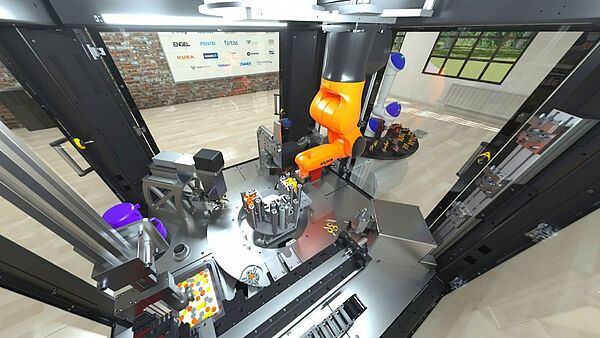Automatica is a leading international exhibition for intelligent automation and robotics and shows its visitors how they can benefit from the digitalization of their production processes. After the exhibition had to be cancelled last year due to Corona, it was now held for the first time as a digital conference from June 22 to 24. The renamed automatica sprint was used by over 3500 participants for professional exchange.
The Institute for Industrial Information Technology was also represented by the two scientific staff members André Mankowski and Philip Priss. They showed a special highlight: The virtual OPC UA demonstrator, which shows the advantages of digital twins, it was presented to a public audience for the first time. Mankowski and Priss were mainly involved here in the conception and implementation of the digital twins and in the design of the virtual showroom, such as the Twitch live stream.
The OPC UA Demonstrator represents the digital image of a real assembly machine in which the viewers can virtually immerse themselves. In this way, even non-visible information technology processes become comprehensible: e.g. OPC UA Companion Specifications, skills calls or the management shell. At the online exhibition, the inIT staff presented the "physical" demonstrator as well as its virtual image. Questions from the audience could be answered directly by the experts.
The demonstrator presented shows that cross-domain interoperability is already a reality. It provides an important basis for applications such as asset management, data mining, condition monitoring, virtual commissioning, machine learning and many other business cases.
The visualization of a modular assembly process (manufacturing cell for fidget spinners) serves as an example here. It is intended to illustrate the added value of cross-manufacturer interoperability based on digital twins with OPC UA. A virtual discovery tour through the manufacturing cell allows easy navigation through the object-oriented architecture of the system. Almost every component of the cell represents itself as a digital twin (OPC UA node) and thus provides all kinds of information and interaction options. For example, standardized interfaces can be used to execute component skills or to retrieve or monitor static and dynamic process data. This can be used to create entire control sequences by orchestrating component skills or to perform process analyses for optimization or monitoring.
Interested? Then take a look at the demonstrator in our showroom at https://digitaltwin-vdma.org/.


